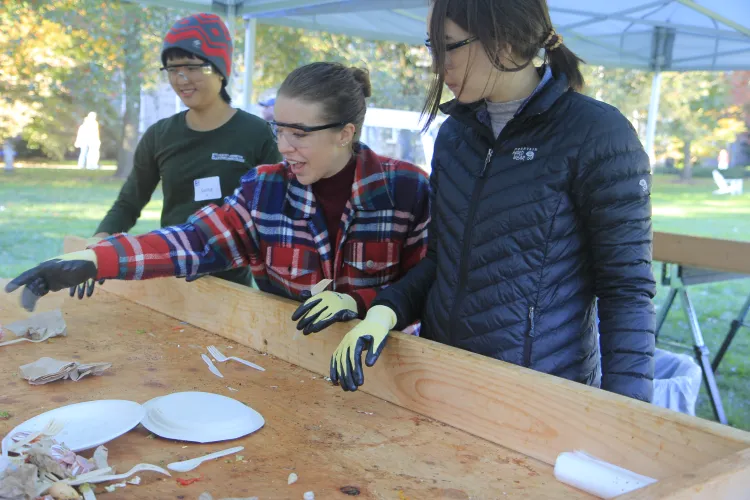Swarthmore Gets Closer to Becoming Zero Waste Campus

Swarthmore students stopped by the Zero Waste Working Group's station on Parrish Beach to help sort waste gathered from across campus.
Swarthmore’s Zero Waste Working Group held its second Waste Characterization Study last month, gathering data on how effectively the College community diverts waste from the Covanta incinerator in Chester, Pa., as part of the College's Zero Waste initiative.
The group gathered waste from several campus buildings and set up a station on Parrish Beach earlier this fall, where interested passersby could participate in sorting the waste. The effort succeeded not just in identifying gaps in the College's waste management systems but increasing the visibility of the Zero Waste effort on campus, members of the working group say.
The study was an opportunity “for our community to engage with its waste in a unique and impactful way,” says Terrence Xiao ’20, of Beijing, China, a 2017 President’s Sustainability Research Fellow (PSRF) and one of the organizers of the study.
“The visceral, hands-on experience of seeing our waste, physically sorting through it and measuring it, is a valuable learning experience for the average individual at Swarthmore, who otherwise will rarely think about the waste that we produce and its broader significance,” he adds.
The 2017 Waste Characterization Study shows an overall increase in waste diversion from last year, says Xiao, meaning that the community is sending a greater ration of overall trash to recycling and compost facilities, rather than to the incinerator. Additionally, the campus is sorting its trash better than last year, and the potential for waste diversion has increased thanks to the use of more compostable products.
However, the study did not show as large of an improvement in waste diversion as expected, with significantly higher performance at 101 S. Chester Road, where departments are working collaboratively to become the College's first Zero Waste building.
The first Waste Characterization Study was conducted in fall 2016 and provided data on Swarthmore’s waste diversion rate and the potential composition of its waste streams, allowing the Zero Waste Working Group to better structure its efforts. For instance, one key takeaway from the first study was the need for behavioral changes, so this year’s PSRF waste project was focused on waste education. Other recommendations, such as the roll-out of new waste stations (each including trash, recycling, and compost bins) across campus and the expansion of composting are also being implemented through a multi-year plan.
"We are thrilled by the enthusiasm that the College community has shown for this Zero Waste initiative," says Melissa Tier '14, sustainability program manager, "and are eager to meet the demand for more educational resources and more compost bins."
In addition to the members of the Zero Waste Working Group, says Tier, student Green Advisors, staff and faculty Sustainability Advocates, and members of the College's Sustainability Committee are resources to help community members practice proper waste sorting. For more information, contact ZeroWaste@swarthmore.edu.



